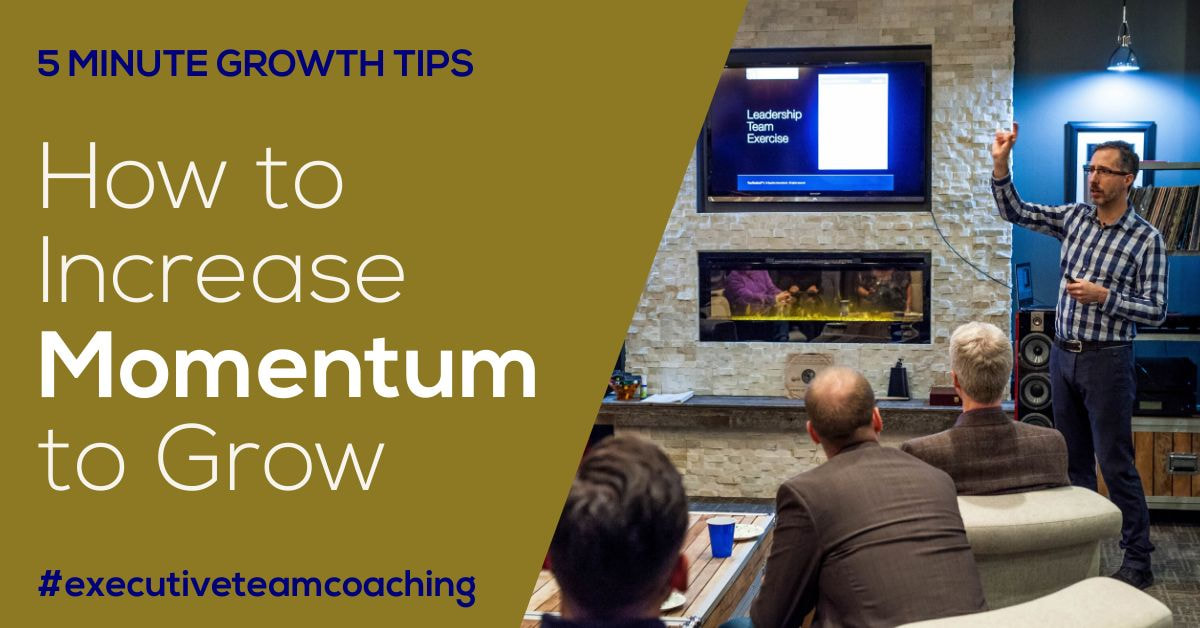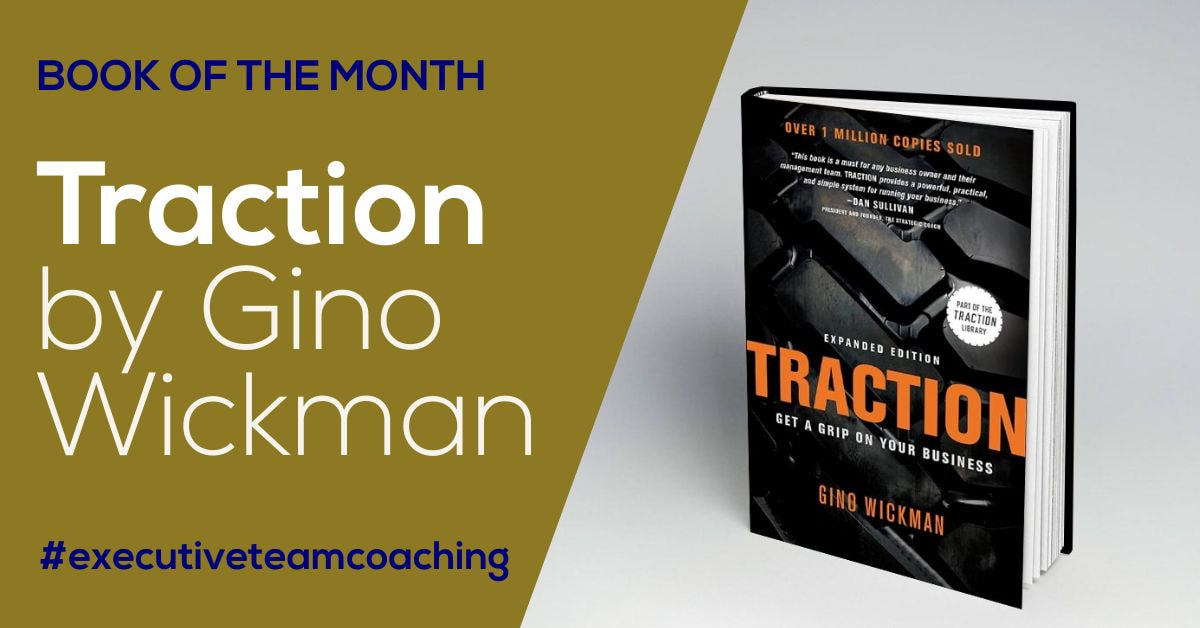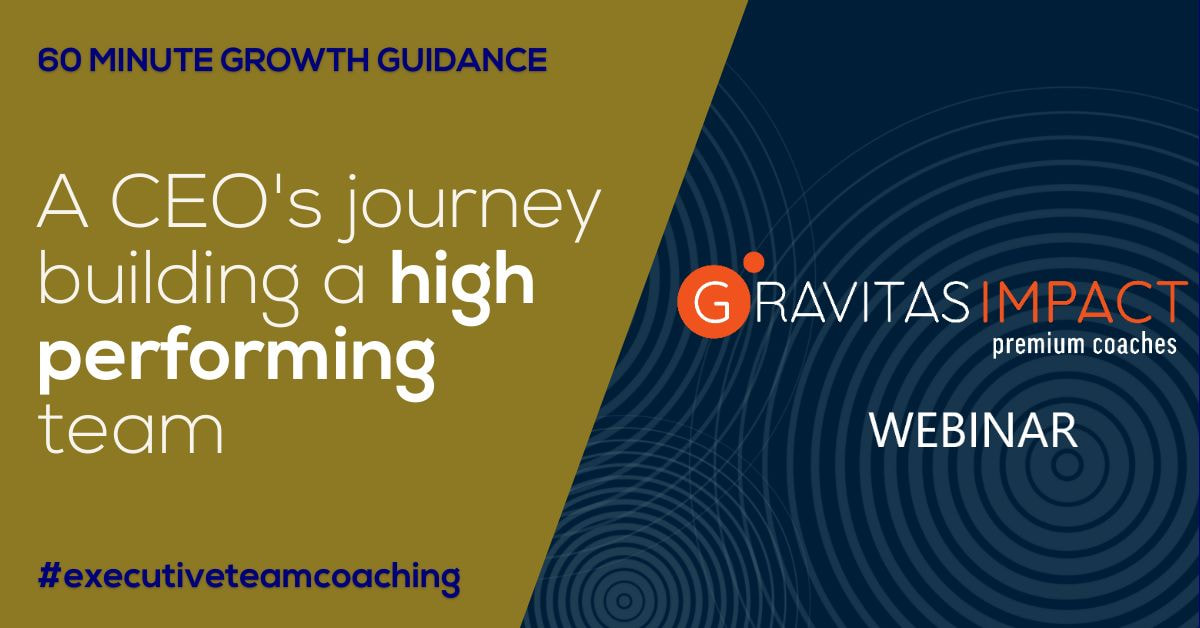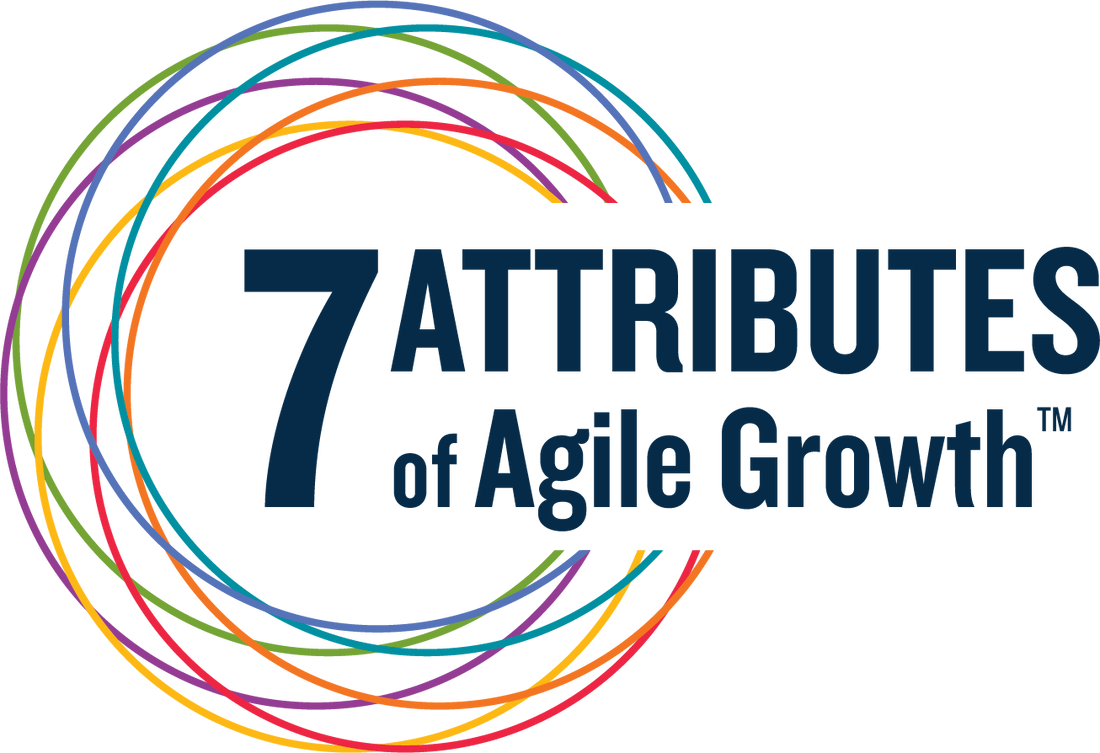|
In the previous 5 Minute Growth Tip article, I shared how companies need to implement structures, processes and systems in order to grow. Without this, they either won’t grow beyond the limits of their current structures, or they will grow inefficiently and increasingly unprofitable.
But as an owner or CEO tries to grow their company to 50, 100 or 200 employees, they may feel like the company is no longer making real progress with those kinds of improvements. Any changes they want to make in their company don’t seem to get done, or don’t get done right. So, how can CEOs increase their momentum? We know that, as a company grows, the CEO increasingly has to get things done through their top team. I covered this also in this previous article. The members of their top team are the ones who need to lead improvement projects within each of their departments and between and across departments. The two keys to making this happen are 1) efficient leadership team buyin, and 2) accountability for execution. Why progress slows with growth When a company is small, less than 10 or 15 employees, it’s more straightforward to get improvement projects done. Often, as CEOs, we just do these projects ourselves. As we begin to delegate these improvement projects, we simply ask a supervisor or front-line employee to get them done. If they are a strong employee, they will usually make it happen. When we have 25, 50 or 100 employees, it gets harder. The reason is what’s called “the power differential”: the difference between the influence of the CEO and the influence of others. In a smaller company, the owner is a strong voice that is heard more easily among the small group of employees. There are often no other voices that are similarly strong (unless of course there is one or more partners involved). It’s also easy to see when someone in a small group is not following through on a project. So each employee has a strong motivation to follow through on the owner’s direction. In a smaller company, there is a large power differential. As the company gets larger, the power differential decreases. As some departments get larger (eg. a production department), the leaders of those departments gain influence. They have now become critical people for the productivity and profitability of the company. The owner no longer has that same strong singular voice. One or more other leaders have strong voices as well. They tend to have more influence about decisions made for the company, and certainly their own department. As well, the owner becomes more detached from the front-line and may feel less confident about what is the right thing to do. The other influential leaders now often have a better perspective on what needs to be done in the operations. This also increases their influence. The owner may therefore feel less influence to be able to simply ask others to take on and carry out improvement projects they dream up. They know they need these high-influence leaders to make things happen. And they may recognize that they lose their leaders' commitment and initiative when they just tell them what to do. The result is that getting leaders to make changes and improvements in and across a mid-size company becomes more challenging than getting front-line employees and supervisors to do so in a smaller company. The trick is in the two keys: 1) efficient leadership team buy-in, and 2) team-based accountability. Efficient Leadership Team Buyin Rather than a CEO figuring out on their own what needs improving and changing for the company, and simply delegating those projects to others, they need to shift to making decisions for the company in collaboration with the members of their top team. This will enable them and their top team members to make company decisions that they’re all committed to. In short, as the saying goes, “people support what they help to create”. This doesn’t mean the CEO doesn’t get the final say. It’s how they get to a final decision that needs to be adjusted. Patrick Lencioni, in his best-selling book, The Five Dysfunctions of a team, called this approach “disagree and commit”. The top team discusses the problem or opportunity and gets all the information out on the table for consideration. Options are discussed and weighed. All members of the top team have the opportunity to share their perspectives and concerns. If an agreement is easily made, then great. If not, the CEO makes the final decision with everyone knowing their perspective has been heard and considered, and agreeing that now is the time to commit to the final decision. This approach allows for effective leadership team participation, while keeping it efficient. This can be a game-changer for CEOs who have already shifted to involving their top team in decision-making, but have gone too far. Their decision-making may have slowed to a crawl, or decisions simply don’t get made, because they and their leadership team members don’t always agree on what’s best. And the CEO isn’t willing to make a final decision for fear that their leaders won’t buy in at all. “Disagree and commit” solves this problem. Accountability for Execution Once there is top team buyin to a decision, how do we ensure accountability for its execution? Buyin is certainly important for accountability. But it’s not enough. Accountability ensures that leaders assigned with taking on certain improvement projects follow through as best as humanly possible. Accountability also means being open and transparent when a project or special effort doesn’t go as planned, so all possible action can be taken to get it back on track. Accountability, also, is more difficult as a company grows. And it’s also due to the changing power differentials. Simply following up one-on-one with individual leaders no longer works as well. Leaders of larger departments have more influence, and their performance is more hidden in a larger company. So there is less pressure to follow through. The solution is again a team approach. Mark Green, a colleague of mine in Virginia, and a peer member of Gravitas Impact Premium Coaches, captured the key ingredients for accountability in his recent monograph titled “Creating a Culture of Accountability”. There are three ingredients for accountability:
Self-accountability is where the CEO, as the leader of the team, leads by example by acting accountably themselves, ensuring they have the right people in the right seats on their leadership team, and raising their expectations of their leaders. Role accountability is about ensuring each leader is clear about their own and each others’ accountabilities. This includes defining the specific results expected for each role and the metrics that make those expectations clear. Note that it’s just as important for leaders to be clear on each others’ roles as their own. This ensures only one person is accountable for each function and everyone is clear on what to expect from others. Process accountability includes communicating about decisions they’ve made in a way that maintains leaders’ natural motivation to execute. This includes believing in their ability to succeed, reminding them why it matters and paying attention to their progress. Process accountability also involves: - ensuring planning happens before action, and on a consistent basis, - having a rhythm of effective and efficient meetings that ensures regular follow-up on progress and results, - and regular one-on-one coaching between the CEO and each leadership team member to develop and support performance. From leading individuals to leading the top team Efficient leadership team buy-in and team-based accountability for execution are the two keys for CEOs to enable continual improvement to grow their mid-size companies. And we can see a common thread for the CEO: shifting from directing individuals to leading and building the top team. This shift can be challenging for CEOs who have become comfortable with a directive style. Yet shifting to leading the top team is critical to getting their leaders bought in, executing, and making more progress. But is it really progress if you’re not going in the right direction? And how do you know if you are? More on that in my next 5 Minute Growth Tip article. How can you increase your momentum? To find out how to make more progress to grow more easily, quickly and profitability, AND enjoy the ride, try our complimentary Agile Growth Checklist. This self-service questionnaire takes 5 to 10 minutes to complete. You'll receive the checklist with your responses immediately. Within 24 hours, you'll receive a compiled report highlighting areas to improve. Complete sections 1 and 4 to check your company’s leadership team and execution processes. Or complete all 7 sections to find out how your company is doing in each of the 7 areas needed to produce more rapid, profitable and sustainable growth. This report is complementary and involves no obligation. As you work with your leadership team on building your business and organization to grow more easily, profitably and sustainably, it helps to have a methodology or set of tools to use, rather than figuring out on your own what best practices to implement.
Over the 17 years I’ve been working with CEOs and their leadership teams, I’ve learned to implement a half dozen methodologies, including the Scaling Up method and the 7 Attributes of Growth tools. Traction, a book written by Gino Wickman, summarizes another such methodology: EOS (the Entrepreneurial Operating System). Like Scaling Up and the 7 Attributes of Growth, it goes beyond setting mere mission, vision, values and priorities to also address people and execution. This isn’t coincidental. Gino was a coach in our network several years ago and used our tools. He then founded his own network of coaches and wrote Traction to capture his approach. Scaling Up and the 7 Attributes of Growth were written since that time and included many best practices that Gino did not, like the daily huddle and cash flow optimization tools. That said, Gino includes a couple of unique tools I have found useful, for example, the People Analyser and the Visionary-Integrator model, which I sometimes implement with the CEOs and leadership teams I work with. The People Analyser is a simple form to quickly evaluate each employee against the company’s core values. The companies I work with use this as input to our talent assessment where leadership team members assess each of their direct reports and then hold each other accountable to coach them up or out. The Visionary-Integrator model is a way for dynamic, creative owners and CEOs to pick and effectively work with a co-CEO who is stronger in the disciplined, structured and organizational aspects of running the company that are needed to enable predictable, profitable and sustainable growth. It enables the owners to do what they do best while also having someone with the other critical skills needed to truly move the business forward. Gino packages the best practices he selected into the six areas of EOS: Vision (including high level strategy and execution planning), People, Data (metrics), Issues, Process and Traction (meeting rhythms). EOS and Traction is a solid, simple approach with easy-to-use tools. In my experience, it works best for smaller companies up to about 25 employees. Beyond that, there tend to be certain challenges that come up that EOS doesn’t address, for example: leadership team cohesiveness, team member productivity, effective hiring, leadership mindset, cascading metrics, planning priorities, clear competitive strategy and financial optimization, planning and forecasting. By contrast, Scaling Up and the 7 Attributes of Agile Growth include most of the best practices found in EOS, and also address these additional challenges as they come up. The 7 Attributes of Agile Growth then go beyond to tackle some of the more nuanced challenges of growth like customer experience, systems and change and leaders’ health. See last month’s Book of the Month for more information. If you’re looking for a simplified methodology with user-friendly terminology and a detailed how-to playbook to get started implementing a set of best practices, Traction may do the trick. Book: 251 pgs, 6h56m audio. How can you get more traction? To find out how to make more progress to grow more easily, quickly and profitability, AND enjoy the ride, try our complimentary Agile Growth Checklist. This self-service questionnaire takes 5 to 10 minutes to complete. You'll receive the checklist with your responses immediately. Within 24 hours, you'll receive a compiled report highlighting areas to improve. Find out how your company is doing in each of the 7 areas needed to produce more rapid, profitable and sustainable growth. This report is complementary and involves no obligation. You work 80 hours a week for your company. However, you still don't get around to taking care of the big, important issues such as sales development, process optimization or talent management? In short, your efficiency is very low? Welcome to the club!
Many successful entrepreneurs feel the same way as you. Every day you are overwhelmed by 100 pressing issues that demand your immediate attention. And yet another day when you couldn't take care of your actual, important tasks. Urgent does not mean important You guessed it: the urgent issues are not always the most important. And the big, important issues are rarely urgent - and that is precisely why they are so often postponed. This is a risky maneuver: 1. You fail to continually develop your company and set the course for future growth. 2. You risk burning out too quickly due to the persistently high workload. Every second manager worldwide regularly feels exhausted at the end of their working day - a sure warning sign of burnout. That's just how it is as an entrepreneur, don't you think? But it doesn't have to. I would like to show you seven ways to increase your personal effectiveness. This creates time to tackle the major levers in your company. And you suddenly have time for your family and private life again. Finally time for your big topics Increasing efficiency Way No. 1: Say no more often! Everyone wants something from you, and everything seems urgent. Don't let others dictate your priorities. Decide for yourself which tasks you want to tackle - and which you don't. For each task, ask yourself: Does the task really advance your company? Are you really the one person who can do this job best, or would you be better off somewhere else? What bad thing would happen if you don't complete this task? Don't fill your day with busy tasks. These always seem urgent, but they don't get you anywhere. It's better to say no again and use the freed up time to tackle the big levers in your company. Increase efficiency Way No. 2: Do unpleasant things according to the “first in – first out” principle. Are you one of those people who initially cleaned the apartment or went to sports during your studies in order to avoid unpleasant tasks (study for an exam, start your master's thesis)? Even as an entrepreneur, there are always tasks that are at the bottom of your popularity scale. Just the thought of it makes you uncomfortable. The same mechanism is triggered here as it was during our studies: our brain tries by all means to avoid unpleasant feelings. Therefore, it will reliably provide you with all sorts of rational justifications why you cannot do this unpleasant task now, but instead a completely urgent other task. The result: you push unpleasant topics to the back of your mind. Important tasks remain unfinished. And because you know that this avoidance behavior is wrong, the hole in the pit of your stomach grows deeper every time you think about the task. A real vicious circle. What has helped me to tackle unpleasant tasks consistently is an uncompromising “first in – first out” principle. I work through my tasks in order from bottom to top - either as emails in my inbox or as a to-do list. The order of these tasks is not prioritized and is therefore negotiable. This is how I managed to complete unpleasant tasks one after the other, like a machine. Pro tip: If you have experience with mindfulness meditation , direct your focus specifically on the negative feelings that an unpleasant task triggers in you. If you're like me, you may notice that these feelings are nothing more than physical symptoms (fast pulse, queasy stomach, heat, tingling fingers, etc.). And these often become weaker just by specifically feeling them. Increase efficiency Way No. 3: Only work through your inbox once a day. Are you proud of how quickly and reliably you answer emails? Many people confuse this speed of response with professionalism, reliability and quality of their work. But with every email you answer in between, you allow yourself to be distracted from your actual tasks and impose other priorities. Here's how to spend as little time as possible in your inbox: Set a block the day you work on your inbox. Inquiries that you can answer within two minutes can be dealt with immediately. Leave the remaining emails in your inbox and deal with them chronologically when you get to them. (You should communicate this procedure to your team beforehand.) Increase efficiency Way No. 4: Set yourself fixed blocks for important tasks. You cannot work on any topic that lasts longer than two hours according to the “first in – first out” principle. Because you hardly have time blocks lasting several hours, and these tasks would otherwise clog up your system. Set aside fixed 30-minute blocks each day for longer tasks like this. I like to set blocks like this in the early morning when I have a lot of energy and no meeting requests can get in the way. This way you work slowly but steadily on larger tasks. The constant progress you make will motivate you day after day. Increase efficiency Way No. 5: Only take on as much as you can do in a week. Nothing is more demotivating than long to-do lists. And nothing seems more unprofessional than making team members wait weeks for your response. Therefore, only take on as many tasks as you can safely complete in a week. Plan 80% of your time and leave 20% free for unforeseeable things. This 20% will be filled quickly. For example, I keep Friday free to work through my to-do list, so that the oldest item on my list comes from Monday at most. Increase efficiency Way No. 6: Keep your team up to date. Nothing makes people more uneasy than the feeling of not being up to date. Therefore, give your team an update on the status of all projects, tasks and topics at least once a week. For each task, give a rough estimate of when you will take care of it. But don't get pinned down and say straight away that it could take longer. In this way, you relieve yourself and your team of unnecessary pressure of expectations. If you don't complete a task by the estimated date, don't let the deadline pass silently, but inform the other person as quickly as possible. People don't mind if appointments are postponed. But they want to feel like you're in control of your tasks. Increase efficiency Way No. 7: Don't get tied down to deadlines. Deadlines are poison for your to-do list. Because they act like an accelerant for urgent to-dos that you have to do because they promised. However, these deadlines often distract you from your actually important tasks (e.g. the daily 30-minute blocks). Something will always fly in with a shorter deadline. Don't give in to this activism and take back control of your to-do list. Instead, give your team rough time estimates and update them weekly. This means you can work on your own issues calmly and with concentration and find time every day to take care of the really important tasks. Conclusion The important tasks are never the most urgent. And the urgent tasks are rarely important. Once you have recognized this, you can restructure your calendar so that your work achieves more impact in less time. https://justgrow.eu/blog/ If you're interested in reading more of Olaf articles please visit the website link above. (Please note that Olaf's site is in German but Google translate does an excellent job of instantly translating it to English.) How can you elevate your people to the next level? To find out what you can improve in your leadership team to grow more easily, quickly and profitability, try our complimentary Agile Growth Checklist*. This self-service questionnaire takes 5 to 10 minutes to complete. You'll receive the checklist with your responses immediately. Within 24 hours, you'll receive a compiled report highlighting areas to improve. This report is complementary and involves no obligation. Complete section 1 and 4 to check your leadership team* and accountability processes*. Or complete all 7 sections to find out how your company is doing in each of the 7 areas needed to produce more rapid, profitable and sustainable growth. There are many keys to successful execution…priorities, alignment, measurement, lean principles, and more. However, the most critical element is having the right high-performing leadership team around the CEO/President of the company. Bar none. In this Gravitas Impact Premium Coaches webinar, Sean Knutsen, CEO & Co-Founder of Boveda in Minnesota, talks about his experience successfully building High Performance Leadership Teams. Boveda Inc. is the leading producer of 2-way humidity control solutions for a variety of moisture-sensitive products, including cigars and cannabis. Becoming the global leader in any category doesn’t happen overnight. Becoming the global leader in a category that didn’t even exist is even harder. But that’s what Boveda did and continues to do since 1997. How can you build a high performance leadership team?
To find out how to develop a great top team to grow more easily, quickly and profitability, AND enjoy the ride, try our complimentary Agile Growth Checklist. This self-service questionnaire takes 5 to 10 minutes to complete. You'll receive the checklist with your responses immediately. Within 24 hours, you'll receive a compiled report highlighting areas to improve. Find out how your leadership team is doing in each of the 7 areas needed to produce more rapid, profitable and sustainable growth. This report is complementary and involves no obligation. |
Archives
December 2029
Categories
All
|





 RSS Feed
RSS Feed
